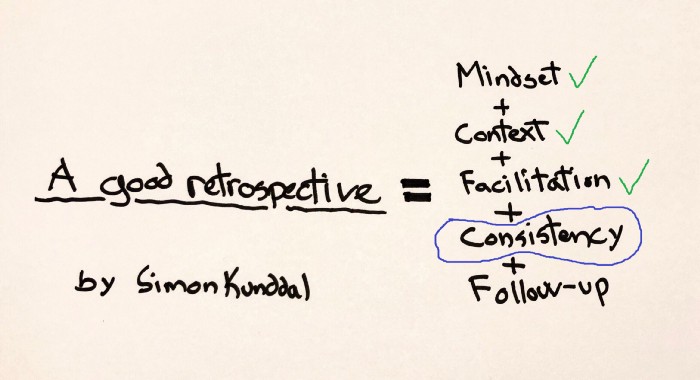
The Retrospective Formula: Consistency — Part 4

If you have not yet read part 1 to 3 of this article series, I highly recommend checking it out, as this will help the understanding of the coming section.
In part 1 of the Retrospective Formula, I explained the importance of having the right mindset when participating in a retrospective. Part 2 was about understanding the environment and circumstances in which the team operates, to have the right focus at the right time. Part 3 addressed some unique facilitation elements that you may want to be aware of. In this section, I will explore the importance of having a consistent flow of retrospectives in your Scrum life cycle.
Consistency — The path to success
Consistency is one of the most important principles for getting the inspect and adapt process up and running. One challenge with the Scrum Framework is that the retrospective is placed at the very end of the sprint. The Daily Scrum event is a daily inspection and adaptation for the team, but it serves another purpose. I will argue that consistency, especially in the Sprint Retrospective, is the path towards being a successful scrum team.
The Scrum Guide — Add each improvement to the sprint backlog
If you are one of the “Scrum by the book” followers, then you might have noticed a change in the recent Scrum guide. It states:
“To ensure continuous improvement, it includes at least one high priority way in which the team works, identified in the previous Retrospective meeting.”
This highlights the need for more focus and attention to the retrospective event. It is not simply a “share-and-talk” event. It clearly states that you have to identify improvements and prioritize it as equally important as any other product backlog item pulled into the sprint backlog
The “Let’s skip retro this sprint, and do a longer retro next sprint” anti-pattern
I often hear team members suggesting: “Let skip this retro, and do a longer session in two weeks”. It is usually heard, when a team is under pressure from reaching the sprint goal. And, it may seem like a natural event to either skip or postpone. I would argue, though, you should rather skip all other meetings if you are in such a situation. The retrospective is the event where you discuss why you are under pressure, and come up with counteractions. If you go from sprint review directly into a new sprint planning, the built up pressure of the system will be maintained, and carried into the next sprint. You may gain 45–60 min by not doing it right now, but current disagreements may escalate into to conflicts during the next sprint if not handled correctly — especially when under pressure. Do not skip it. Ever. Maybe do it shorter than planned if you have to.
Shorter beats irregular
It is in general better to keep it short and consistent, than to have longer retrospective irregularly. And here is why:
Continuous Improvement — Keep a diary
There are many advantages of doing it consistently. First and foremost, you will experience that you improve something every sprint. The mindset from the sprint is also present in the improvement mindset. Improving something smaller every sprint will make sure that team members experience a positive change every sprint. Sometimes, it will be small changes, other times they may be more significant. A colleague of mine recently showed me how keeping a simple diary of the history of the retrospectives could be very powerful. By documenting what improvements has been implemented, what has been closed down, and not yet selected, the team get a very transparent overview of all the improvements.
Fluent Event
Another positive consequence of being consistent is the fluency the team will obtain. The team will get more used to the different formats the facilitator use. This will help members to be more open, and have more courage, as they now know what effect a given exercise can have on conversation and understanding of each other.
Faster Execution
Consistency also leads to faster execution. If everybody have the right mindset for a retrospective, and understands the agenda, you can reach the output and outcome faster. There will be less need for meta-talk between the different stages, and the team members may even take control themselves.
Build an army of facilitators
Last but not least, you will slowly built up an army of great facilitators inside the team. Once a team have been through the different formats and agendas a couple of times, you can actually challenge them by giving individuals the responsibility of being the facilitator. This can be helpful if the Scrum master is either sick or on vacation.
Consistency is an important principle in the retrospective formula as this will drive many other positive factors mentioned above. Next week, we will have a look at the final principle “Following-up”.